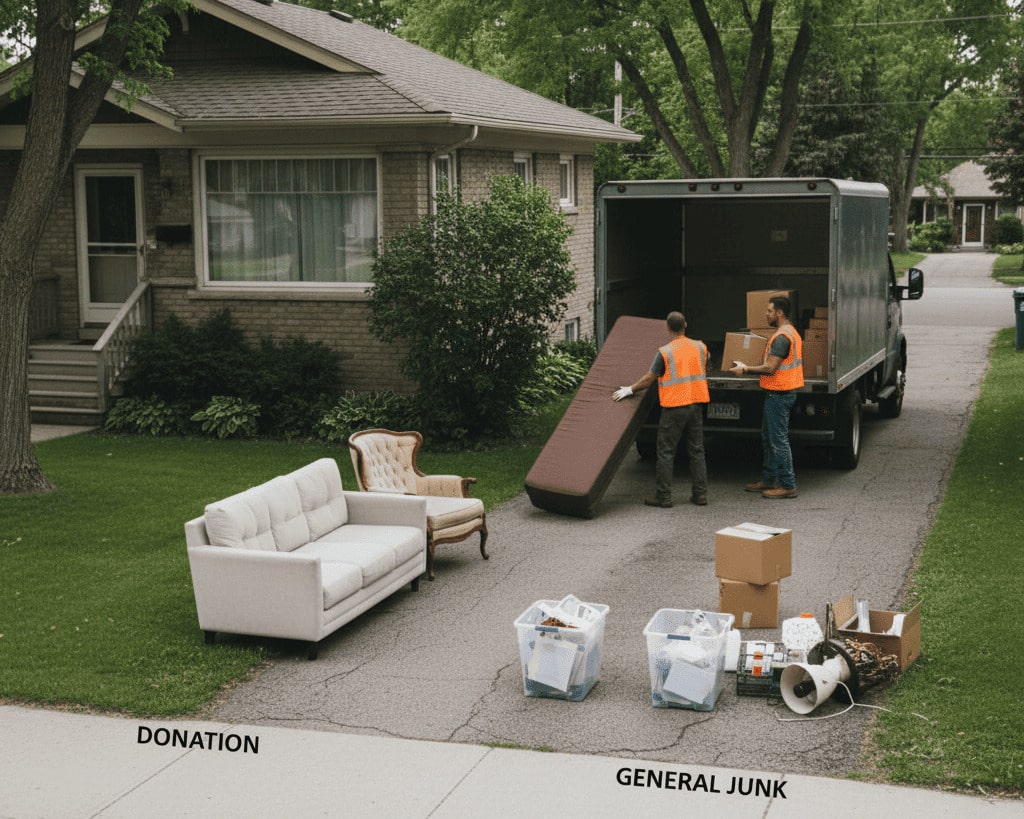Hazardous waste disposal matters for public safety, your household, and Winnipeg’s environment. From old batteries and paint to leftover pesticides, household chemicals, and expired medications, knowing where to dispose
hazardous waste in Winnipeg keeps toxins out of landfills, storm drains, and drinking water. This guide explains what qualifies as hazardous waste, how to store and prepare items safely, the local options for drop-off and stewardship, and when to call a professional service like Mr Garbage to handle pickup and legal routing.
Mr Garbage provides safe hazardous waste pickup and routing across Winnipeg. If you prefer a hands-off approach, our trained crews will collect, sort, and deliver hazardous items to approved processors.
What is hazardous waste disposal, and why does it matter?
Hazardous waste disposal refers to the safe collection, transport, treatment, and final disposal of materials that can harm people, property, or the environment. Household items that are common but hazardous include paint thinners, pesticides, solvents, batteries, flammable aerosols, expired medications, and some cleaning products.
Why this matters locally: hazardous materials improperly thrown away can contaminate soil and groundwater, cause fires at recycling facilities, and risk injury for waste collectors. Manitoba and Winnipeg have formal systems and collection points to prevent these problems; using them protects your family and community.
How to tell whether an item is hazardous
Before asking “where to dispose hazardous waste,” first identify whether the item is hazardous.
Quickly signs that an item is hazardous.
- Labels showing flammable, corrosive, toxic, or explosive hazard symbols.
- Products with solvents, pesticides, or strong acids/bases.
- Batteries (especially lithium-ion), electronics with batteries, and certain aerosols.
- Medical sharps and expired prescription drugs.
- Laboratory chemicals (e.g., formalin/formaldehyde solutions) and leftover industrial products.
When in doubt, check the product’s Safety Data Sheet (SDS) or the manufacturer’s label. For household-sized materials, stewardship programs like Product Care list accepted products and clarify what’s considered household hazardous waste.
productcare.orgCommon household hazardous items and how to classify them
Below are typical items homeowners ask about, and how they’re usually handled.
Paints, thinners, and solvents
- Latex paint is water-based and often accepted by municipal or stewardship collection when prepared according to guidelines.
- Oil-based paints, thinners, and solvents are considered hazardous and require special handling at HHW collection sites. Product Care’s Manitoba HHW program lists accepted paints, aerosols, and solvents at official drop-off locations.
Batteries: Why are batteries hazardous waste?
Batteries contain metals and chemicals (lead, cadmium, mercury, lithium) that can leach into the environment or spark fires if damaged. For those reasons, batteries are classified as hazardous and should be returned to battery collection points or depot programs; do not toss them in regular recycling or garbage. Health Canada highlights battery safety concerns and safe disposal routes.
CanadaMedications and sharps: When disposing of hazardous drug waste in a home setting
Unused or expired medications should not be flushed. Canada’s guidance is to return unwanted medications to a pharmacy take-back program. Manitoba runs a provincial medication return program, and many pharmacies participate. For home-generated medical sharps (needles), use approved sharps containers and return them to designated drop-off locations or pharmacy programs.
CanadaShoe polish: Is shoe polish hazardous waste?
Some shoe polishes contain flammable solvents and hydrocarbons. Small, fully-consumed containers are generally safe to dispose of per local guidelines, but leftover or large volumes with solvent smells should be treated as household hazardous waste and taken to a HHW collection point. When in doubt, follow Product Care guidance for flammable liquids.
productcare.orgFormalin and formaldehyde: Is formalin hazardous waste?
Yes. Formalin (a formaldehyde solution) is toxic and potentially carcinogenic. It requires chemical-hazard handling and disposal; do not pour it down drains or into regular garbage. Formalin should be managed as a chemical hazardous waste through a licensed hazardous waste carrier or institutional hazardous-waste program. Institutional or lab facilities typically follow strict disposal protocols; homeowners with small quantities should contact a professional hauler for safe routing.
CCOHSWhere to dispose of hazardous waste in Winnipeg
Winnipeg and Manitoba offer several reliable options for household hazardous waste. Here’s how to find the right one for your item.
4R Winnipeg Depots and Brady Road Resource Management Facility
Winnipeg operates three 4R depots (Brady, Panet, and Pacific) that accept many household hazardous items and recyclables. The Brady Road facility is the main resource management site for Winnipeg and handles a wide range of materials. Before heading out, check depot guidance on accepted items and hours; some facilities accept hazardous materials while others are for recycling only. These municipal depots are the first port of call for many residents.
City of WinnipegProduct stewardship collection sites (Product Care)
Product Care runs stewardship programs across Manitoba for paint, household hazardous waste (HHW), lights, and other categories. Use Product Care’s Manitoba HHW locator to find approved collection points for paints, aerosols, pesticides, and similar items. These sites follow strict guidelines for safe sorting and processing.
productcare.orgPharmacy and medication-return programs
For expired or unwanted medication and some sharps programs, return items to participating pharmacies under Manitoba’s medication return program. Many community pharmacies accept household drugs year-round as part of the provincial take-back system. This route prevents pharmaceuticals from entering sewers or landfills.
CanadaSpecialty processors and private hazardous-waste carriers
For commercial quantities or unusual chemical wastes (formalin, lab chemicals, large solvent volumes), licensed hazardous-waste carriers and processors handle cradle-to-grave transport and treatment under provincial rules. Manitoba’s hazardous waste compliance guidance explains generator responsibilities and lawful shipping requirements. For large or complicated loads, contact a licensed carrier or a professional hauler such as Mr Garbage to arrange compliant pickup and routing.
manitoba.caPreparing hazardous items for drop-off
Proper preparation speeds acceptance and prevents spills or hazards.
Basic safety steps
- Keep original containers and labels when possible. Labels show content and hazards.
- Ensure lids are tight and containers aren’t leaking or bulging. Put leaky cans into a larger sealed plastic tote before transport.
- Separate incompatible chemicals (e.g., acids from bases, bleach from ammonia).
- Don’t mix unknown chemicals; treat them as hazardous and contact a professional for guidance.
- Keep items upright in the vehicle and ventilate where needed.
If you have damaged or unknown containers, call a professional hauler rather than risk transporting yourself.
How long can hazardous waste be stored on site?
Storage time depends on the type of waste and applicable regulations. For household scales, short-term storage in a safe, labeled, ventilated area is usually acceptable while you arrange disposal. For larger quantities or commercial generators, provincial hazardous waste regulations define permitted storage practices, containment, labelling, and maximum on-site times. Manitoba’s compliance guide outlines generator responsibilities, including prompt transfer and record-keeping. If you’re storing wastes longer than a few weeks or have uncertain volumes, contact a licensed hauler for advice.
manitoba.caWhy do household hazardous waste facilities exist?
Household hazardous waste facilities exist to protect public health and prevent environmental contamination. They provide:
- Safe handling and treatment of materials that could otherwise pollute water or soil.
- Proper recycling and recovery of materials like batteries and certain electronics.
- Fire-risk reduction by diverting flammable materials and damaged lithium batteries away from curbside loads.
- Regulated downstream processing through licensed facilities that follow environmental laws.
Stewardship programs and municipal depots are part of a network that keeps hazardous substances out of the general waste stream.
Real-world examples and local practice
Example 1: Old paint and aerosols
A homeowner with leftover oil-based paints and aerosols took them to a Product Care HHW drop-off in Winnipeg. The site accepted the cans for routing to a processor where usable paint was recovered and solvents were handled under hazardous-waste protocols.
Example 2: Lithium battery sparks
A resident disposed of loose lithium batteries in a recycling bin, causing a small fire at a sorting facility. Since then, local education campaigns emphasize taping battery terminals and using designated battery boxes, a reminder to follow battery-specific rules. Mr Garbage can accept and safely contain batteries for transport to an appropriate recycling partner.
When to call a professional
Call a professional hauler like Mr Garbage when:
- You have leaking or corroded containers.
- You’re unsure what chemicals are in a container.
- You have commercial quantities or large volumes from renovation, estate cleanouts, or construction.
- You need documentation for disposal or regulatory purposes.
Mr Garbage’s trained crew follows regulatory transport rules, uses proper containment, and routes materials to approved processors, reducing liability and protecting your household.
Quick checklist: safe hazardous waste disposal in Winnipeg
- Identify the item type and check the label or SDS.
- Use Product Care and City of Winnipeg depots to find the right drop-off site.
- Store items upright, in original containers, and away from heat.
- Don’t mix chemicals or pour them down sinks or toilets.
- For medicines, return to participating pharmacies; for sharps, use approved sharps containers.
- Call Mr Garbage for pickup if items are leaking, numerous, or if you prefer a professional to handle transport and documentation.
Conclusion
Hazardous waste disposal Winnipeg is straightforward when you know the options: municipal 4R depots and Brady Road, Product Care stewardship sites, pharmacy take-back programs, and licensed hazardous-waste carriers. Correctly identifying items, preparing them safely, and using the right collection program protects your family, neighbours, and the environment.
If you’d like help arranging pickup or need a professional to collect and route hazardous materials, Mr Garbage offers safe, compliant hazardous waste pickup across Winnipeg. Call (204) 999-5865 or book online at
https://mrgarbage.ca/contact/ for trained crews, secure containment, and guaranteed routing to approved processors.
Frequently Asked Questions (FAQs)
Q1: What hazardous waste can I drop off in Winnipeg?
A1: Many household hazardous items are accepted, like paints (especially oil-based), solvents, pesticides, aerosols, batteries, certain cleaners, and fluorescent lights. Use Product Care’s Manitoba HHW locator and City of Winnipeg 4R depots to confirm specific acceptance.
Q2: Is shoe polish hazardous waste?
A2: Some shoe polishes contain flammable solvents. Small, fully empty containers can often be disposed of according to local guidance, but leftover polish with solvents should be treated as HHW and taken to a collection site. Check the product label and Product Care guidance.
Q3: When disposing of hazardous drug waste in a home setting, what should I do?
A3: Do not flush medicines. Return unused or expired medications to participating pharmacies or medication take-back programs in Manitoba. Use approved sharps containers for needles and return them through authorized programs.
Q4: Is formalin hazardous waste, and how should I dispose of it?
A4: Yes. Formalin (formaldehyde solution) is toxic and should be managed as chemical hazardous waste. Do not pour it down drains. Contact a licensed hazardous-waste carrier or professional hauler like Mr Garbage to arrange safe pickup and disposal.
Q5: Why are batteries considered hazardous waste, and how should I dispose of them?
A5: Batteries contain heavy metals and reactive chemistries that can leach toxins or cause fires if damaged. Return household batteries to designated battery drop-off points or stewardship programs; tape terminals of lithium batteries and never put loose batteries in curbside bins. Health Canada and local depot guidance explain safe handling.

